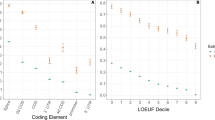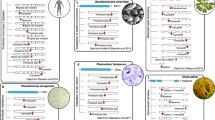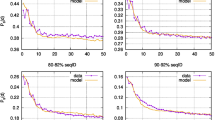Abstract
Hurst et al.1 and, earlier, McDonald2 confirm the pattern of amino-acid gain and loss that we report3. However, they attribute this pattern to properties of the mutation-selection equilibrium, arguing that gainer amino acids are more common than losers among weakly deleterious, rare polymorphisms, which segregate within one or both compared species but never reach fixation. Indeed, we all1,2,3 concur that gainers are, mostly, under-represented, whereas losers are over-represented with respect to mutations (Table 3 of ref. 3). Still, we cannot agree that the effect of weak negative selection is a viable alternative to our original explanation.
Similar content being viewed by others
Main
Hurst et al. show that the observed pattern is similar to that expected from the mutation process1. This is inconsistent with their own hypothesis in that the observed trend would be significantly weaker than the mutational bias owing to the effect of negative selection against deleterious mutations.
As we3 and Hurst et al.1 have shown, up to 30% of all substitutions contribute to the observed pattern for strong gainers and losers, even in relatively distant species at about 15% amino-acid divergence. Under the hypothesis of Hurst et al., this would require about 4.5% of amino-acid sites in a genome to be occupied by deleterious alleles contributing to gain and loss. This is an order of magnitude greater than the divergence between many analysed bacterial species (Table 1 of ref. 3). Therefore, the trend cannot be explained according to Hurst et al., even under the unrealistic assumptions that all deleterious polymorphism contributes to gain and loss, that all amino-acid polymorphism is deleterious, and that the divergence between bacterial species is due entirely to within-population polymorphism.
Direct comparison of amino-acid polymorphism and divergence can clarify whether the presence of non-fixed amino-acid variants is the main cause of the observed pattern. At present, comprehensive single-nucleotide-polymorphism data are available only for Homo sapiens. Although purifying selection is relaxed in humans compared with most other species4,5, more than 10% of human amino-acid alleles are deleterious5,6,7,8. Thus, the human data can be used to analyse the effect of deleterious polymorphism on the trend. Only 2.6% of the non-synonymous differences between the public human genome and the chimpanzee genome coincide with the differences between the public genome and the Celera individual-A genome sequence. Given a similar polymorphism level in the chimpanzee, about 5% of the human–chimpanzee divergence is expected to be due to non-fixed mutations. Thus, even if all polymorphism resulted from segregation of rare deleterious gainer alleles, the observed pattern, which substantially exceeds 5% for eight out of nine strong gainers and losers, cannot be explained by polymorphism.
If mutations producing gainers and mutations eliminating losers were deleterious, levels of gain and loss in polymorphism would be substantially higher than in divergence, and the shift in allele frequency distribution would be observed in corresponding single nucleotide polymorphisms. However, the data on human single nucleotide polymorphisms do not conform to this expectation (see, for example, Table 2 of ref. 3).
We conclude that mutation-selection equilibrium is not an acceptable explanation of the universal trend in amino-acid gain and loss.
References
Hurst, L. D., Feil, E. J. & Rocha, E. P. C. Nature 442, doi:10.1038/nature05137 (2006).
McDonald, J. H. Mol. Biol. Evol. 23, 240–244 (2006).
Jordan, I. K. et al. Nature 433, 633–638 (2005).
Eyre-Walker, A., Keightley, P. D., Smith, N. G. & Gaffney, D. Mol. Biol. Evol. 19, 2142–2149 (2002).
Chimpanzee Sequencing and Analysis Consortium Nature 437, 69–87 (2005).
Fay, J. C., Wyckoff, G. J. & Wu, C. I. Genetics 158, 1227–1234 (2001).
Sunyaev, S. et al. Hum. Mol. Genet. 10, 591–597 (2001) .
Yue, P. & Moult, J. J. Mol. Biol. 356, 1263–1274 (2006).
Author information
Authors and Affiliations
Corresponding author
Rights and permissions
About this article
Cite this article
Jordan, I., Kondrashov, F., Adzhubei, I. et al. Causes of trends in amino-acid gain and loss (Reply). Nature 442, E12 (2006). https://doi.org/10.1038/nature05138
Published:
Issue Date:
DOI: https://doi.org/10.1038/nature05138
This article is cited by
-
Uniquely Localized Intra-Molecular Amino Acid Concentrations at the Glycolytic Enzyme Catalytic/Active Centers of Archaea, Bacteria and Eukaryota are Associated with Their Proposed Temporal Appearances on Earth
Origins of Life and Evolution of Biospheres (2013)
-
Enzyme-Driven Speciation: Crystallizing Archaea via Lipid Capture
Journal of Molecular Evolution (2007)
Comments
By submitting a comment you agree to abide by our Terms and Community Guidelines. If you find something abusive or that does not comply with our terms or guidelines please flag it as inappropriate.



